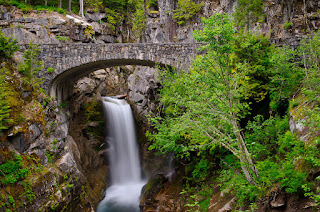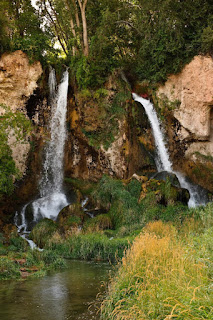1. What do I need?
The only equipment you need for shooting waterfalls is a camera and a tripod. Some optional equipment that would be great to have but not required are a polarizer filter and a cable release. The camera is self-explanatory, the tripod is to have a stable platform for long exposures. A polarizer will reduce glare of the water and a cable release will help with camera shake because you are not touching the camera when you expose the image.
2. How long do I exposure for?
This answer is as varied as is people's taste. I break the waterfall into two categories, one where you wan to show the power of the gushing water and have more detail in the water. The second is where the silky smooth effect shows the grace and beauty of the falls.
 I set my camera to manual and change the ISO to 100. My aperture is set to achieve maximum focus, usually f/8 to f/11. For big falls I try to achieve a shutter speed below 1 second, anything between 1/4 and 1 second. This will still show the motion in the water and still retain detail in that movement.
I set my camera to manual and change the ISO to 100. My aperture is set to achieve maximum focus, usually f/8 to f/11. For big falls I try to achieve a shutter speed below 1 second, anything between 1/4 and 1 second. This will still show the motion in the water and still retain detail in that movement.To achieve a longer shutter speed I adjust to a smaller aperture, even f/22. With this I can achieve a shutter speed of 1-4 seconds, this will achieve the silky smooth water effect.
3. Wide Angle or Zoom Lenses?

Take both wide-angle and zoom lenses to photograph waterfalls. High and powerful waterfalls can release large amount of water into the air, getting you or your camera wet or damaged. Use a telephoto lens such as 70-200mm to photograph falls from a distance and a wide-angle lens such as 16-35mm if the falls are smaller and you are standing close to them.
4. When to go?
Depending on the water source of the waterfall, it may look drastically different throughout the seasons. If the waterfall is fed by snowmelt it might be dried up by the end of summer. Late spring or early summer are usually the best time to visit them.
Lighting conditions also affect when you should try to shot waterfalls. Balanced and diffused light is great for waterfalls because it helps bring out details in the shadows and amplify the contrast. The best diffused light occurs on overcast days, but if not then try visiting during sunrise or sunset. Try to avoid when half of the waterfall is in the shade and half is sunlit.






